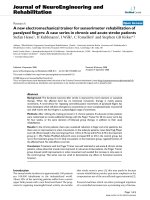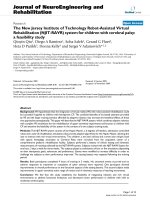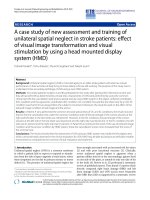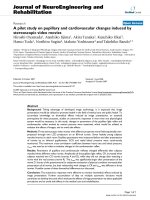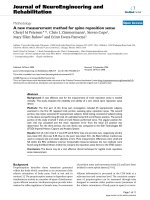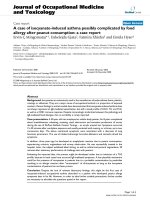Báo cáo hóa học: " A new electromechanical trainer for sensorimotor rehabilitation of paralysed fingers: A case series in chronic and acute stroke patients" pdf
Bạn đang xem bản rút gọn của tài liệu. Xem và tải ngay bản đầy đủ của tài liệu tại đây (661.68 KB, 6 trang )
BioMed Central
Page 1 of 6
(page number not for citation purposes)
Journal of NeuroEngineering and
Rehabilitation
Open Access
Research
A new electromechanical trainer for sensorimotor rehabilitation of
paralysed fingers: A case series in chronic and acute stroke patients
Stefan Hesse
1
, H Kuhlmann
1
, J Wilk
1
, C Tomelleri
1
and Stephen GB Kirker*
2
Address:
1
Klinik Berlin, Department Neurological Rehabilitation, Charité – University Medicine Berlin, Germany and
2
Addenbrooke's
Rehabilitation Clinic, Cambridge University Hospitals NHS Foundation Trust, Cambridge, CB2 2QQ, UK
Email: Stefan Hesse - ; H Kuhlmann - ; J Wilk - ; C Tomelleri - labor@reha-
hesse.de; Stephen GB Kirker* -
* Corresponding author
Abstract
Background: The functional outcome after stroke is improved by more intensive or sustained
therapy. When the affected hand has no functional movement, therapy is mainly passive
movements. A novel device for repeating controlled passive movements of paralysed fingers has
been developed, which will allow therapists to concentrate on more complicated tasks. A powered
cam shaft moves the four fingers in a physiological range of movement.
Methods: After refining the training protocol in 2 chronic patients, 8 sub-acute stroke patients
were randomised to receive additional therapy with the Finger Trainer for 20 min every work day
for four weeks, or the same duration of bimanual group therapy, in addition to their usual
rehabilitation.
Results: In the chronic patients, there was a sustained reduction in finger and wrist spasticity, but
there was no improvement in active movements. In the subacute patients, mean distal Fugl-Meyer
score (0–30) increased in the control group from 1.25 to 2.75 (ns) and 0.75 to 6.75 in the treatment
group (p < .05). Median Modified Ashworth score increased 0/5 to 2/5 in the control group, but
not in the treatment group, 0 to 0. Only one patient, in the treatment group, regained function of
the affected hand. No side effects occurred.
Conclusion: Treatment with the Finger Trainer was well tolerated in sub-acute & chronic stroke
patients, whose abnormal muscle tone improved. In sub-acute stroke patients, the Finger Trainer
group showed small improvements in active movement and avoided the increase in tone seen in
the control group. This series was too small to demonstrate any effect on functional outcome
however.
Introduction
The annual stroke incidence is approximately 180 patients
per 100,000 inhabitants in the industrialized world.
About 30% of the surviving patients suffer from a severe
upper limb paresis with a non functional hand. The prog-
nosis for regaining meaningful hand activity six months
after stroke onset is poor [1]: this may partly be because
current rehabilitation practice puts more emphasis on the
compensatory use of the non-affected upper extremity [2].
Powered machines which can allow prolonged repetition
of a controlled movement are a promising way of increas-
Published: 4 September 2008
Journal of NeuroEngineering and Rehabilitation 2008, 5:21 doi:10.1186/1743-0003-5-21
Received: 8 February 2008
Accepted: 4 September 2008
This article is available from: />© 2008 Hesse et al; licensee BioMed Central Ltd.
This is an Open Access article distributed under the terms of the Creative Commons Attribution License ( />),
which permits unrestricted use, distribution, and reproduction in any medium, provided the original work is properly cited.
Journal of NeuroEngineering and Rehabilitation 2008, 5:21 />Page 2 of 6
(page number not for citation purposes)
ing the intensity of rehabilitation after stroke. Several
devices, to treat wrist, elbow & shoulder movements, have
been developed since the pioneering MIT-Manus in the
early 1990s [3]. Randomized controlled trials show a con-
vincing beneficial effect of robot-assisted upper limb treat-
ment on the impairment of severely affected stroke
patients [4-9].
There are fewer clinical reports of machine-assisted move-
ment of paralysed fingers. The Rutgers Hand Masters I and
II use pistons mounted inside the palm to move the fin-
gers, with virtual reality to improve motivation. Chronic
stroke patients improved range of motion, motor control
and speed of the paretic fingers over several weeks of train-
ing, and the benefits were retained at follow-up [10,11].
With the Howard Hand Robot, pistons assist with patient
initiated grasping and releasing movements around vir-
tual or real objects. In moderately affected chronic stroke
subjects, upper limb motor functions improved, and func-
tional MRI revealed increased sensorimotor cortex activa-
tion during the grasping task which was not seen during a
non-practiced task, supination/pronation [12].
Fischer et al assisted the finger extension of mildly affected
stroke patients with the help of a powered orthosis. Fol-
lowing six weeks of training in reach-to-grasp of virtual
and actual objects, patients' active motor performance
had shown a moderate improvement [13].
The treatment of the plegic fingers after stroke is pertinent
given their large cortical representation, the presumed
competition between proximal and distal limb segments
for plastic brain territory [14], and recent results from the
MIT-group promoting earlier active treatment of distal
limb [15]. Further, paresis-related immobilization seems
to contribute to the development of long-term disabling
finger flexor spasticity [16].
We have designed an electromechanical Finger Trainer to
move individual fingers in a physiological range of move-
ment. This article describes the device and reports its use
in a small number of chronic and acute stroke patients
with completely paralysed hands.
Device
The Finger Trainer, Reha-Digit, (figure 1) consists of four,
mutually independent plastic rolls, each fixed eccentri-
cally to the powered axle of the device, forming a cam-
shaft. Each finger-roll can be repositioned & secured by
turning a knob on the main axle, on the other end from
the motor, to fit the size & range of movement of each
individual finger.
The surface of each finger roll is concave, forming a gutter
to maximise the contact area between finger & roll. Two
smaller locking rollers, also concave, hold each finger
against the larger finger roll. Each pair of locking rollers
moves orthogonally to the axis of the finger roll, and an
elastic spring pulls each pair of locking rollers towards the
finger roller. These can be lifted out of the way when first
positioning the hand & fingers in the device.
A spacing bar, parallel to the drive axle, holds the hand in
the optimal position: a thumb stop may be used to pro-
vide additional stability. This can be moved to either side,
The Finger Trainer, "Reha-Digit", without a patient (left), and a left-hemiparetic patient practicing with the device (right)Figure 1
The Finger Trainer, "Reha-Digit", without a patient (left), and a left-hemiparetic patient practicing with the
device (right).
Journal of NeuroEngineering and Rehabilitation 2008, 5:21 />Page 3 of 6
(page number not for citation purposes)
to accommodate either the left or right hand. There are
emergency-stop switches at each end of the spacing bar.
The forearm can be stabilised at the correct angle & height
on a gutter support.
A 24 V DC motor rotates the drive axle up to 30 times a
minute through a clutch mechanism, which allows the
axle to stop rotating if the hand goes into a powerful
spasm. A vibration engine, situated under the base plate,
provides small amplitude (2 mm) stimulation at a fre-
quency which can be set between 0 to 30 Hz, by turning a
knob. The device's weight is 7 kg, and its dimensions are
35 cm × 24 cm × 22 cm.
Treatment
The patient sat comfortably on a chair with a backrest,
with the device on a height-adjustable table in front of
him. A therapist positioned the forearm on the arm sup-
port, placed the patients' four fingers II – V onto the cam
shaft, and placed the thumb behind the spacing-bar or
under the thumb-stop. The patient should not report any
pain. In case of severe finger flexor spasticity, the therapist
manually reduced the muscle tone before putting the
hand in the device, and ultrasound contact gel could be
applied to the fingers to diminish the friction between fin-
gers and finger-rolls.
Initially, the rotation speed of the cam shaft and the vibra-
tion frequency were set at 20 rotations per minute and 20
Hz. After three minutes the treatment was interrupted in
order to modify the treatment conditions regarding posi-
tioning, rotation speed and vibration frequency. The
patient practised a total of 15 min with the device. The
patients were instructed to concentrate on the movement
of the paretic fingers and, if possible, to imagine that they
themselves performed the finger movements.
To avoid saturation of the Meissner organs by continuous
tactile dynamic stimulation of the finger tips by the
revolving rolls, strips with different surface texture were
attached to the inner surface of the concave roll of the
index finger, and the patients were asked to discriminate
between them. Patients with arthritis of the finger joints,
soft tissue pain or hand swelling were excluded.
Case series
Chronic patients
Two male chronic stroke patients, aged 55 (#1) and 67
(#2) years, had suffered a supratentorial left hemisphere
stroke resulting in a right hemiparesis 17 and 22 months
before study onset. They participated in a comprehensive
4 week in-patient rehabilitation programme for chronic
stroke patients. The rehab programme included 45 min-
utes each of Bobath orientated physiotherapy and occupa-
tional therapy every workday, of which upper limb
rehabilitation made up about 15% of physiotherapy and
30% of occupational therapy time.
The patients did not take any oral muscle relaxants, and
had no botulinum toxin injections in the preceding 3
months. Both were ambulatory and almost competent in
the basic activities of daily living. The paretic upper
extremity was severely affected, i.e. non-functional, and
the fist was clenched due to severe wrist and finger flexor
spasticity. The modified Ashworth scores (0–5) [17], was
4/5 for the fingers and 3/5 for wrist in both patients. The
Fugl-Meyer Motor Score for the upper limb (FM, 0–66)
[18], was 7 and 9 respectively. Pain, touch and position
sensation, and two-point discrimination were unim-
paired.
Initially, a therapist had to open the clenched fist before
starting the treatment, and the rollers were lubricated with
ultrasound gel. Immediately after the first treatment ses-
sion, the finger and the wrist flexor spasticity had reduced
to 2/5 and 2/5 respectively on the modified Ashworth
scale in both patients, and this effect lasted for about 15
minutes. Over 4 weeks of treatment 5 days/week, the dis-
tal tone reduction became persistent. Both patients had a
modified Ashworth score of 2/5 for the fingers, tested
while supine before the daily treatment session started,
and the wrist scores were 2/5 (# 2) and 3/5 (#1). Passive
hand care was easier, although active hand function did
not change considerably; the FM scores were 9 and 13
respectively.
Pilot study in sub-acute patients
The exploratory pilot study, approved by the local ethical
committee, included eight hemiparetic patients who gave
written informed consent. They suffered from a middle
cerebral artery infarct 4–6 weeks earlier (additional file 1).
The subjects were at least mobile in wheelchairs, and their
Barthel Index (BI, 0–100) ranged from 55 to 70. Their
upper limb was flaccid, and they could not volitionally
extend the wrist or fingers: the FM score (0–66) ranged
from 5 to 18. MRC grades of motor power are shown in
additional file 3. The sensation was normal or only mildly
affected, when tested for pain, touch, two-point discrimi-
nation, and position sense. All patients were already par-
ticipating in a comprehensive in-patient rehabilitation
programme including 45 min of physiotherapy and 30
min of occupational therapy every workday. The major
treatment goals were restoration of stance and gait, and
independence in ADL. About 15% of total therapy time
was devoted to upper limb work, such as shoulder mobi-
lisation, holding the paretic arm extended while lying,
weight acceptance tasks over the fully extended arm and
bilateral manoeuvres such as moving a duster on a table.
Journal of NeuroEngineering and Rehabilitation 2008, 5:21 />Page 4 of 6
(page number not for citation purposes)
After consent, the patients were randomly allocated to two
groups, A and B, by drawing a lot from an envelope. Both
groups continued with conventional therapy. Group A
had additional 20 minutes on the Finger Trainer each
work day for 4 weeks, and group B had the same duration
of daily group practice of bimanual upper limb exercises,
in which the patient held a dusting cloth in their weak
hand and pushed it over the surface of a table with their
strong hand.
The assessments before and after the 4 week intervention
included the FM (total upper limb 0–66 and total distal
0–30), the Box & Block test [19], a sum score of muscle
power (0–30, wrist and finger flexion/extension and
thumb abduction and adduction) based on the MRC
(0–5), and a sum score of muscle tone (0–15, resistance
to passive wrist and finger extension and thumb abduc-
tion, tested while supine) based on the modified Ash-
worth score (0–5). None of the highly paretic patients was
able to transfer a block within the Box & Block test ini-
tially. The FM assessment (0–66) was videotaped with a
mirror placed in an angle of 45° placed behind the
patient, and an experienced therapist who was blinded
with respect to the group assignment assessed & scored
the videos of all patients.
Results
In addition to their regular programme, the four A group
patients practised with the Finger Trainer for 20 minutes
every workday for four weeks. The cam shaft rotation
ranged from 20 to 25 revolutions/minute, and the vibra-
tion frequency from 25 to 35 Hz. Therapy-related side
effects did not occur. Results for the 8 sub-acute stroke
patients are shown in additional file 2 and additional file
3. The mean distal Fugl-Meyer score increased in the con-
trol group from 1.25 > 2.75 (ns) and 0.75 > 6.75 in the
treatment group (p < .05, paired t test vs baseline & t test
vs control final scores). Median Modified Ashworth score
increased in the control group, but not in the treatment
group. The distal upper limb muscle strength improved to
a similar degree (see additional file 3). Only one patient,
in the treatment group, showed any improvement in
active hand function, becoming able to transfer 16 blocks
within one minute (additional file 2). He also used his
paretic hand functionally in daily life, for instance when
pulling off his pullover or holding objects, e.g. a tooth-
paste tube. He was not able to open the tube with his
affected hand. The remaining seven subjects did not spon-
taneously use their affected hand. The Barthel Indices of
all patients improved, and there was no apparent group
difference (additional file 3). Subjectively, the four A
group patients were positive about treatment with the Fin-
ger Trainer as they felt something was happening with
their paretic hand and the asynchronous movement of the
fingers in combination with the vibration felt comforta-
ble.
Discussion
The Finger Trainer is a newly developed device for the sen-
sory-motor rehabilitation of the plegic fingers after stroke.
This small study shows a clinically significant difference in
spasticity in the treatment & control groups, which would
require a larger series to test statistically. We were pleas-
antly surprised to find a statistically significant improve-
ment in Fugl-Meyer score in such a small trial and this
certainly justifies a larger study to give more conclusive
results. Patients tolerate and even like using it. Side effects
did not occur, although we avoided patients with pre-
existing hand pain, arthritis or soft tissue problems, as we
felt these people were most likely to develop problems. It
remains to be seen if arthritis, which is very common
among people in the age range who have strokes, is aggra-
vated or helped by repetitive gentle movement.
The two chronic patients showed reduced resistance to
passive finger movements. Prolonged immobilization of
the joint could have resulted in changes in the soft tissue
and joint compliance associated with developing contrac-
tures [16] and the repetitive passive movement of the fin-
gers may have improved soft tissue compliance. The
vibration could also have played a role: Ahlborg et al., for
instance, reported a tone-diminishing effect on the knee
extensors in adults with cerebral palsy following whole-
body vibration [20].
None of the four sub-acute A group patients, but three B
group patients, developed a clinically significant increase
in the resistance to passive finger extension. This finding
supports the recommendation of Pandayan et al. that pas-
sive movements around the joints in non-functional
patients should begin very early during their rehabilita-
tion programme to prevent contractures [16].
The fingers share one of the largest cortical representation
areas in the primary motor area. Two studies using several
complementary techniques have shown that passive limb
movements, such as those made by the Finger Trainer,
cause activation in the sensorimotor cortex in the same
areas as active movements [21,22]. In healthy subjects,
positron emission tomography has shown that active and
passive elbow movements resulted in identical strong
increases in regional blood flow in the sensorimotor cor-
tex [21]. Similarly magnetencephalography has revealed
dipolar sources within 1 cm of the central sulcus follow-
ing passive finger movement [22].
While this evidence shows the benefit of passive move-
ments, active movements do lead to greater cortical and
muscle activation. Lotze et al measured changes in activa-
Journal of NeuroEngineering and Rehabilitation 2008, 5:21 />Page 5 of 6
(page number not for citation purposes)
tion in the contralateral primary motor cortex (cM1)
using fMRI and transcranial magnetic stimulation (TMS)
following 30 min of either active or passive wrist exten-
sion in healthy subjects [23]. While passive movements
caused some increase in activation, active training led to
more prominent increases in fMRI activation, recruitment
curves (TMS) and intracortical facilitation (TMS). The
authors concluded that the results were consistent with
the concept of a pivotal role for voluntary drive in motor
learning. Accordingly, the finger trainer in its present form
is rather limited as it only offers a passive movement,
unlike the Rutgers Hand Master and the Howard Hand
robot [10,12]. However, it is intended primarily for stroke
patients with plegic fingers.
For this subgroup of severely affected patients, who are
unable to actively move their fingers, sensory stimulation
may be particularly important. Hummelsheim et al.
reported that, compared to voluntary muscle activation, a
similarly strong facilitation of movement was obtained
with cutaneous and proprioceptive stimuli in severely
affected patients [24]. In adult owl monkeys, Jenkins et al.
reported that functional cortical remodelling of the S1
koniocortical field resulted from cutaneous stimulation of
a limited sector of skin on the distal phalanges [25]. Byl et
al. successfully used attended, graded, repetitive sensory
and motor training activities, 1.5 hours per week for eight
weeks, to improve the fine motor control and sensory dis-
crimination tasks in chronic stroke patients [26]. Somato-
sensory stimulation, delivered via electrical stimulation,
also positively influenced the sensorimotor recovery in
chronic stroke patients [27,28].
To enhance the sensory stimulation provided by the Fin-
ger Trainer, strips with different surface texture were
attached to the inner surface of the concave roll of the
index finger, and the patients were instructed to discrimi-
nate the different textures. Secondly, vibration was
applied to primarily activate the Paccini corpuscles of the
finger tips. Since the vibration motor was under the cam
shaft, the small amplitude vibration was not only felt in
the distal phalanges but in the whole arm up to the shoul-
der. There is neurophysiological evidence in cats [29] and
humans [30] that sensory stimulation induces long-term
potentiation in the motor cortex, and increases corticospi-
nal excitability. In clinical studies of stroke patients, Shira-
hashi et al. reported that vibratory stimulation on the
hand facilitated voluntary movements of a hemiplegic
upper limb [31]. Tihanyi et al. showed that one bout of
whole body vibration transiently increased voluntary
force and muscle activation of the quadriceps muscle
affected by stroke [32].
In conclusion, the inexpensive Finger Trainer is a simple
way of providing more intensive stimulation and passive
stretching of plegic fingers after stroke. These preliminary
results suggest further studies to examine its effect on
muscle tone, ease of care, pain & active function are justi-
fied.
Competing interests
The spouse of the first author owns the company, Reha-
Stim, holding the national patent.
Authors' contributions
SH conceived the device and study, and drafted the man-
uscript. HK manufactured the device. JW recruited, treated
and assessed the patients. CT designed the device. SGBK
helped with the design & analysis of the study and the
preparation of the manuscript. All authors reviewed the
final manuscript.
Additional material
Acknowledgements
The "Gesellschaft zur Förderung der Neurologischen Rehabilitation e.V."
supported the study.
References
1. Kwakkel G, Kollen BJ, an der Grond J, Prevo AJ: Probability of
regaining dexterity in the flaccid upper limb. The impact of
severity of paresis and time since onset in acute stroke.
Stroke 2003, 34:2181-2186.
2. Hesse S, Werner C, Bardeleben A: The severely affected arm
after stroke: more research needed. Neurol Rehabil 2004,
10:123-130.
3. Hogan N, Krebs HI, Charnarong J, Sharon A: Interactive robotics
therapist. Cambridge, Massachusetts Institute of Technology: US
Patent No.5466213; 1995.
4. Aisen ML, Krebs HI, Hogan N, McDowell F, Volpe BT: The effect of
robot-assisted therapy and rehabilitative training on motor
recovery following stroke. Arch Neurol 1997, 54:443-6.
5. Volpe BT, Krebs HI, Hogan N, Edelstein OTRL, Diels C, Aisen M: A
novel approach to stroke rehabilitation: robot-aided sensori-
motor stimulation. Neurology 2000, 54(10):1938-1944.
Additional file 1
Table 1: Clinical data of both groups at study onset
Click here for file
[ />0003-5-21-S1.doc]
Additional file 2
Table 2: Individual and mean (SD) values of movement & function of
both groups at study onset and study end.
Click here for file
[ />0003-5-21-S2.doc]
Additional file 3
Table 3: Individual and mean (SD) values of power & muscle tone of both
groups at study onset and study end.
Click here for file
[ />0003-5-21-S3.doc]
Publish with BioMed Central and every
scientist can read your work free of charge
"BioMed Central will be the most significant development for
disseminating the results of biomedical research in our lifetime."
Sir Paul Nurse, Cancer Research UK
Your research papers will be:
available free of charge to the entire biomedical community
peer reviewed and published immediately upon acceptance
cited in PubMed and archived on PubMed Central
yours — you keep the copyright
Submit your manuscript here:
/>BioMedcentral
Journal of NeuroEngineering and Rehabilitation 2008, 5:21 />Page 6 of 6
(page number not for citation purposes)
6. Hesse S, Werner C, Pohl M, Rueckriem S, Mehrholz J, Lingnau ML:
Computerized arm training improves the motor control of
the severely affected arm after stroke. A single-blinded ran-
domized trial in two centres. Stroke 2005, 36:1960-1966.
7. Lum PS, Burgar CG, Shor PC, Majmundar M, Loos M van der: Robot-
assisted movement training compared with conventional
therapy techniques for the rehabilitation of upper-limb
motor function after stroke. Arch Phys Med Rehabil 2002,
83:952-959.
8. Masiero S, Celia A, Rosati G, Armani M: Robotic-assisted rehabil-
itation of the upper limb after acute stroke. Arch Phys Med
Rehabil 2007, 88:142-149.
9. Barker RN, Brauer SG, Carson RG: Training of reaching in stroke
survivors with sever and chronic upper limb paresis using a
novel nonrobotic device. Stroke 2008, 39:1800-7.
10. Boian R, Sherman A, Han C, Merians A, Burdea G, Adamovich S,
Recce M, Tremaine M, Poizner H: Virtual-reality-based post-
stroke hand rehabilitation. Stud Health Technol Inform 2002,
85:64-70.
11. Adamovich S, Merians A, Boian R, Recce M, Tremaine M, Poizner H:
A virtual reality based exercise system for hand rehabilita-
tion post-stroke: transfer to function. Conf Proc IEEE Eng Med
Biol Soc 2004, 7:4936-4939.
12. Takahashi CD, Der-Yeghiaian L, Le V, Motiwala RR, Cramer SC:
Robot-based hand motor therapy after stroke. Brain 2008,
131(Pt 2):425-37.
13. Fischer HC, Stubblefield K, Kline T, Luo X, Kenyon RV, Kamper DG:
Hand rehabilitation following stroke: a pilot study of assisted
finger extension training in virtual enviroment. Top Stroke
Rehabil 2007, 14:1-12.
14. Muelbacher W, Richards C, Ziermann U, Wittenberg G, Weltz D,
Boroojerdi B, Cohen L, Hallett M: Improving hand function in
chronic stroke. Arch Neurol 2002, 59:1278-1282.
15. Krebs HI, Volpe BT, Williams D, Celestino J, Charles SK, Lynch D,
Hogan N: Robot-aided neurorehabilitation: a robot for wrist
rehabilitation. IEEE Trans Neural Syst Rehabil Eng 2007, 15:327-335.
16. Pandyan AD, Cameron M, Powell J, Scott DJ, Granat MH: Contrac-
tures in the post-stroke wrist: a pilot study of its time course
of development and its association with upper limb recov-
ery.
Clin Rehabil 2003, 17:88-95.
17. Bohannon RW, Smith MB: Interrater reliability of modified Ash-
worth spastic scale of muscle spasticity. Phys Ther 1987,
67:206-207.
18. Fugl-Meyer AR, Jääskö L, Leyman I, Olsson S, Steglind S: The post-
stroke hemiplegic patients. Scand J Rehab Med 1975, 7:13-31.
19. Mathiowetz V, Volland G, Kashman N, Weber K: Adults norms for
the Box & Block test of manual dexterity. Am J Occup Ther
1985, 39:386-391.
20. Ahlborg L, Andersson C, Julin P: Whole-body vibration training
compared with resistance training: effect on spasticity, mus-
cle strength, and motor performance in adults with cerebral
palsy. J Rehabil Med 2006, 38:302-308.
21. Weiller C, Jüptner M, Fellows S, Rijntjes M, Leonhardt G, Kiebel S,
Müller S, Diener HC, Thilmann AF: Brain representations of
active and passive movements. Neuroimage 1996, 4:105-110.
22. Lange R, Nowak H, Haueisen J, Weiller C: Passive finger move-
ment evoked fields in magnetoencephalography. Exp Brain Res
2001, 136:194-199.
23. Lotze M, Braun C, Birbaumer N, Anders S, Cohen LG: Motor learn-
ing elicited by voluntary drive. Brain 2003, 126:866-872.
24. Hummelsheim H, Hauptmann B, Neumann S: Influence of physio-
therapeutic facilitation techniques on motor evoked poten-
tials in centrally paretic hand extensor muscles.
Electroencephalogr Clin Neurophysiol 1995, 97:18-28.
25. Jenkins WM, Merzenich MM, Ochs MT, Allard T, Guic-Robles E:
Functional reorganization of primary somatosensory cortex
in adult owl monkeys after behaviourally controlled tactile
stimulation. J Neurphysiol 1990, 63:82-104.
26. Byl N, Roderick J, Mohamed O, Hanny M, Kotler J, Smith A, Tang M,
Abrams G: Effectiveness of sensory and motor rehabilitation
of the upper limb following the principles of neuroplasticity:
patients stable post stroke. Neurorehabil Neural Repair 2003,
17:176-191.
27. Peurala SH, Pitkänen K, Sivenius J, Tarkka IM: Cutaneous electrical
stimulation may enhance sensorimotor recovery in chronic
stroke. Clin Rehabil 2002, 16:709-716.
28. Celnik P, Hummel F, Harris-Love M, Wolk R, Cohen LG: Somato-
sensory stimulation enhances the effects of training func-
tional hand tasks in patients with chronic stroke. Arch Phys
Med Rehabil 2007, 88:1369-1376.
29. Sakamoto T, Arissian K, Asanuma H: Functional role of the sen-
sory cortex in learning motor skills in rats. Brain Res 1989,
503:258-64.
30. Kaehlin-Lang A, Luft AR, Sawaki L, Burstein AH, Sohn YH, Cohen LG:
Modulation of human corticomotor excitability by somato-
sensory input. J Physiol 2002, 540:623-33.
31. Shirahashi I, Matsumoto S, Shimodozono M, Etoh S, Kawahira K:
Functional vibratory stimulation on the hand facilitates vol-
untary movements of hemiplegic upper limb in a patient
with stroke. Int J Rehabil Res 2007, 30:227-230.
32. Tihanyi TK, Horvath m, Fazekas G, Hortobagyi T, Tihnyi J: One ses-
sion of whole body vibration increases voluntary muscle
strength transiently in patients with stroke. Clin Rehabil 2007,
21:782-793.

